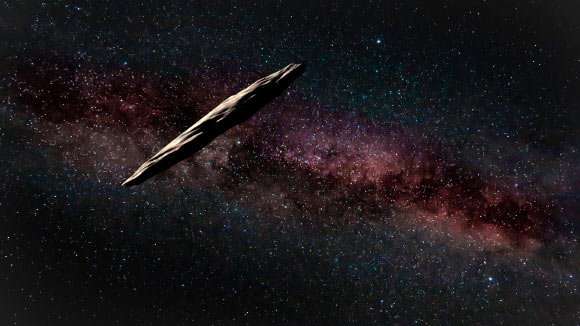Did we just get visited by an alien probe?
Back in October of 2017, astronomer reported spotting a mysterious object traveling through our solar system and about a month after it made its closest approach to the sun.
After that, it swung back around into a trajectory that will see it leave the solar system one day.
But the mystery object was unlike anything we’ve ever seen.
Moths after ‘Oumuamua was discovered, the behavior of the object baffled astronomers.
For example, astronomers reported seeing a small but persistent acceleration that they could not explain simply by the gravitational pull of the Sun.
As the observations appeared, there was a series of reclassifications and revisions of the theories: it was classified as a comet, then as an asteroid and, finally, as an interstellar object.
Theories about its origin include everything from being a planetary fragment to a remnant of a spacecraft from an alien civilization.
But was it REALLY aliens?
If you ask Dr. Avi Loeb, the head of Harvard University’s astronomy department there’s a great chance we may have actually been visited by an alien probe.
The scientific community, however, greatly disagrees.
After all, aliens don’t exist, right?
A new theory proposes a different perspective from that of Dr. Loeb.
According to astronomers from Yale and Caltech, ‘Oumuamua is just a comet that ‘rocks’.
“It has left a number of mysteries in its wake,” said Yale graduate student Darryl Seligman.
Seligman is the first author of a study about ‘Oumuamua accepted for publication by the Astrophysical Journal Letters.
Seligman, as well as Yale astronomy professor Gregory Laughlin and Caltech professor Konstantin Batygin (the man behind planet Nine), explain the reason for Oumuamua’s weird acceleration as it traveled away from the sun is quite mundane: it was probably caused by the ventilation of gas (outgassing) that was heated by the sun, as the object made its closest approach to our solar system’s star.

And that, say, experts, is not unusual at all.
In a statement published by Yale, the researchers reveal that such ‘outgassing’ happens regularly for comets, the researchers noted. As a comet approaches the Sun and heats up, its ice erupts in a jet. Comet “tails” are formed when dust particles get caught in the jet and reflect sunlight.
However, there are no signs that ‘Oumuamua has a tail, or that it ever had one.
But not only that ‘Oumuamua also does not display the telltale spin that would be caused by a gas jet, say experts.
“In the model, we’re proposing for ‘Oumuamua, the venting gas does not erupt from a single fixed point on the surface,” Laughlin said.
“Instead, the jets migrate along the surface, following the warmth and tracking the direction to the Sun.”
Hence, astronomers propose that instead of spinning up as a typical solar system comet, ‘Oumuamua appears to rocks back and forth just like a pendulum.
Astronomers also indicate that the discovery of ‘Oumuamua suggests that nearly every star in the galaxy may eject such objects during the planet formation process.
If that is true, a new generation of telescopes such as the Large Synoptic Survey Telescope (LSST) in Chile may help scientists learn more about them.
Whatever the weird object may be, it will take it around 10,000 years to leave our solar system. By then, hopefully, we will have new, more advanced telescopes that could actually see what the mystery object is.











